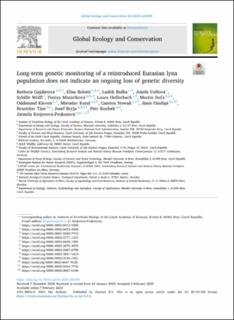Long-term genetic monitoring of a reintroduced Eurasian lynx population does not indicate an ongoing loss of genetic diversity
Gajdárová, Barbora; Belotti, Elisa; Bufka, Luděk; Wölfl, Sybille; Mináriková, Tereza; Hollerbach, Laura; Dul'a, Martin; Kleven, Oddmund; Kutal, Miroslav; Nowak, Carsten; Ozoliņš, Jānis; Tám, Branislav; Bryja, Josef; Koubek, Petr; Krojerová-Prokešová, Jarmila; Volfová, Josefa
Peer reviewed, Journal article
Published version

Åpne
Permanent lenke
https://hdl.handle.net/11250/3059746Utgivelsesdato
2023Metadata
Vis full innførselSamlinger
- Publikasjoner fra CRIStin - NINA [2364]
- Scientific publications [1392]
Originalversjon
10.1016/j.gecco.2023.e02399Sammendrag
Where reintroduced wildlife populations are considered as vulnerable this is generally due to
limited founder size and isolation. While many of these populations show low levels of genetic
diversity, little is known about the temporal patterns of genetic diversity loss and the role of
initial founder effects vs. ongoing genetic drift. Here we analysed genotype data from 582
Eurasian lynx samples from the reintroduced Bohemian-Bavarian-Austrian population (BBA) over
a time span of 35 years, representing approximately 13 generations. Two-wave reintroduction of
lynx from at least two distinct West-Carpathian areas resulted in relatively high start-up of genetic
diversity. After the initial decline when the population lost about a quarter of its genetic diversity
compared to the Carpathian source population, the genetic diversity and effective population size
remained almost unchanged over the next 20 years. Despite confirmed isolation of BBA and thus
absence of gene flow, we detected relatively low inbreeding during the two recent decades within
the slightly increasing population size, which may have prevented ongoing loss of genetic diversity. Given the current status of BBA, we do not support genetic reinforcement to maintain its
long-term viability; but urge the importance of facilitating gene flow with neighbouring lynx
populations through an improvement of landscape connectivity and by strengthening law
enforcement as well as the prevention of illegal killings. A sound genetic monitoring alongside
regular camera trap-based monitoring of population size, health status and reproduction is pivotal
to decide on future conservation interventions.
